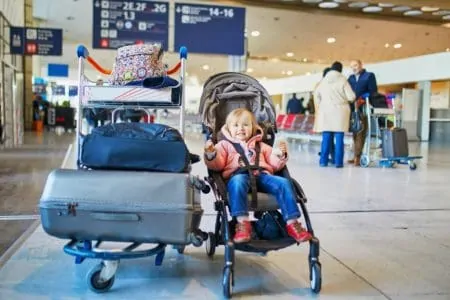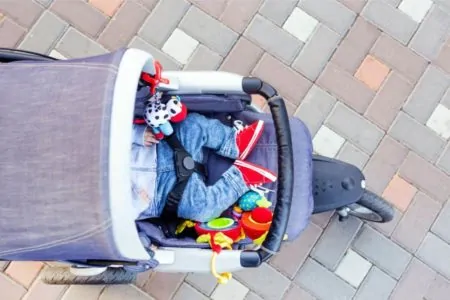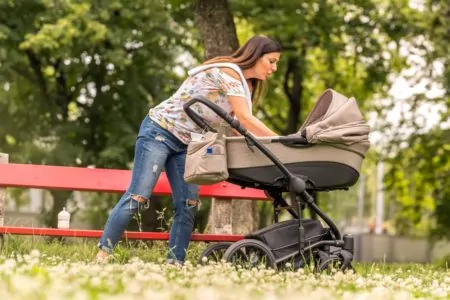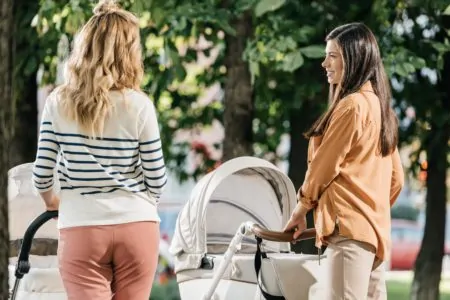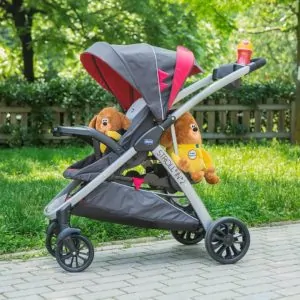Ready to ditch the carrier and roll with a stroller? It is a huge milestone for you and your baby. But before you strap your little one in for a cruise around the block, you need to know if they are physically ready for the ride.
Strollers come with endless features, shapes, and sizes. They are a lifesaver for parents on the move. Let’s explore exactly when it is safe to start using one and how to pick the perfect model for your lifestyle.
Key Takeaways
- Babies can usually sit in a standard stroller around 3 months old, or once they can support their own head.
- Newborns require a stroller that fully reclines or a travel system with a car seat attachment.
- Your lifestyle dictates your choice; consider terrain, trunk space, and public transport needs.
- Safety is paramount, so always check for stability, functioning brakes, and a secure five-point harness.
When Can Babies Use a Stroller?
The right age for stroller use depends on your specific baby’s development. However, there is one golden rule. Your baby must be able to support their own head before you place them in a stroller with a sitting position.
Some strollers are designed as bassinet styles specifically for newborns. These allow the baby to lie completely flat. Strollers that do not recline fully are generally not safe for babies under 3 months old. This is typically when your infant develops enough neck muscle to hold their head up without assistance (1).
Every child develops at their own pace. Use your judgment and consult your pediatrician if you are unsure if your baby is ready to sit upright.
Most infants that I see at the 4-month-old well-care visit have established consistent head control. In premature infants, this milestone may be delayed by a few weeks or months, depending on the birth age. Before the age of 4 months, I recommend strollers in which the infant lies flat. Once you notice your infant raising their head, doing a “belly crunch” maneuver, it is OK to use a stroller with a raised back. For more on premature infant milestones, read this article by the AAP.
Editor's Note:
Dr. Leah Alexander, MD, FAAPHow to Choose the Right Stroller
You will likely use this gear almost every day until your child becomes a confident walker. Therefore, you need to choose a stroller that fits your life and adapts to your growing child.
Consider your budget and your daily routine. Do you need something rugged for trails or sleek for the subway? There are lightweight options, double strollers, and versatile travel systems.
Here are the top factors to weigh before buying (2).
1. Your Baby’s Age
If your baby is under 3 months old, you need a model that reclines fully or accepts an infant car seat. Standard upright strollers are not safe yet. A convertible stroller is often a smart investment because it accommodates newborns and adjusts as they grow into toddlers.
If you are planning for a second child, look at strollers that convert from single to double.
2. Your Lifestyle
How do you get around town? Your primary mode of transport dictates the type of wheels you need.
Car-Friendly
If you drive everywhere, trunk space is your main concern. You need a stroller that fits easily into your vehicle. Look for lightweight frames or models that fold down compactly.
Active Lifestyle
Do you love jogging or hiking? You need a sturdy frame with excellent suspension. This protects your baby from bouncing around too much. Look for “all-terrain” wheels and easy maneuverability.
Note that dedicated jogger strollers are generally not recommended for babies under 6 to 8 months old.
Public Transport
Subways and buses present unique challenges. You want a stroller that is light enough to carry up stairs and compact enough to fold in a crowded bus aisle. Some models even come with a carry strap for backpack-style transport.
3. Stroller Weight and Size
Measure your doorways and your car trunk. You do not want to buy a dream stroller only to find it doesn’t fit through your front door.
Also, consider the lifting factor. If you live in a walk-up apartment, lugging a 25-pound stroller plus a baby is a workout you might not want. Check the product weight before clicking “buy.”
4. Handle Height
Pushing a stroller should not hurt your back. Handle height is vital, especially if you and your partner have a significant height difference.
Hunching over or reaching up to push causes strain. Look for adjustable or telescoping handlebars so you can both push comfortably.
5. Wheel Type
Large, air-filled tires are great for jogging strollers and rough terrain. They offer a smooth ride but add bulk.
For mall trips or smooth sidewalks, smaller plastic or foam wheels are fine. Look for front wheels that swivel for agility but can lock into place for stability over bumps.
6. Capacity Needs
Do you need one stroller to do it all? Or do you prefer a specialized approach? Some parents buy a full-size stroller for neighborhood walks and a cheap umbrella stroller for travel.
If you stick to one stroller, ensure it meets your most frequent needs. Don’t pay for off-road suspension if you only walk inside the mall.
7. Accessories and Features
Decide which extras are deal-breakers. Do you need a massive storage basket for groceries? Is a cup holder essential for your morning coffee?
Common features include snack trays, rain covers, sun canopies, and peek-a-boo windows. Check which accessories are included and which are sold separately.
8. Budget
Strollers range from budget-friendly to luxury status symbols. You do not need the trendy brand just because a celebrity has it. Many affordable models offer excellent safety and durability.
Buy the best quality you can afford that ticks your boxes. A slightly more expensive convertible model might save you money in the long run by eliminating the need to buy a second stroller later.
Main Features of Different Stroller Types
Navigating the stroller aisle can feel overwhelming. Let’s break down the main categories to help you decide.
1. Umbrella or Lightweight Models
These are best for babies over 6 months who can sit up unassisted. They are the ultimate “grab-and-go” option.
Umbrella strollers are named for their curved handles. They feature lightweight frames and fold vertically, making them easy to store. Most weigh very little, sometimes as light as 5 to 10 pounds.
They usually do not recline fully and have minimal suspension, so they aren’t for newborns or rough terrain.
2. Portable or Compact Strollers
These sit between umbrella and full-size models. They offer more comfort than an umbrella stroller but are less bulky than a travel system.
They usually feature a decent storage basket, a canopy, and a sturdier fold mechanism. Higher-end models may offer a full recline, making them suitable for newborns.
3. Full-Size Strollers
These are the heavy-duty cruisers. They come with everything: forward and rear-facing seats, massive storage baskets, snack trays, and plush padding.
They are comfortable for the baby and convenient for the parent, but they are heavy. If the seat reclines fully, you can use them from birth through the toddler years (around 4 years old).
Many of the parents of twins and triplets I see in my practice use these types of strollers because all of the infants can fit in one stroller. While this is easier than trying to push more than one stroller simultaneously, keep in mind that they can be more cumbersome. With these types of strollers, a parent will always need to use an accessible ramp or elevator. Also, the “outward-facing” versions may have an obstructed view of the infant or toddler. It is important to ensure all straps and harnesses are secure, and that there are no choking hazards in proximity to the child.
Editor's Note:
Dr. Leah Alexander, MD, FAAP4. Travel Systems
A travel system is a stroller and matching car seat sold together. You can click the infant car seat directly into the stroller frame. This allows you to move a sleeping baby from the car to the stroller without waking them.
Once the baby outgrows the infant seat, the stroller functions on its own. These systems are incredibly popular for their versatility from day one.
5. Jogger Strollers
True joggers usually feature a three-wheel design with large, air-filled tires. They are built to handle speed and bumps.
Features often include a hand brake, wrist strap, and superior suspension.
Warning
Keeping Baby Safe in a Stroller
The Juvenile Products Manufacturers Association (JPMA) provides critical guidelines for stroller safety. Keep these tips in mind:
- Check Stability: The base should be wide enough to prevent tipping. Ensure the stroller doesn’t tip backward when you hang a diaper bag on it (better yet, use the bottom basket).
- Use Seatbelts: Always buckle your baby in. A five-point harness is the safest option to prevent climbing out or sliding down.
- Use Brakes: Engage the parking brake every time you stop, even on flat ground.
- Watch Fingers: Keep your baby’s hands clear of the folding mechanism when you open or close the stroller.
- Avoid Overloading: Do not hang heavy purses or shopping bags on the handlebars. This is the number one cause of strollers tipping over.
For more details, check the Nemours Hospital stroller safety checklist.
FAQs
In Conclusion
Choosing the right stroller is about freedom. It gives you the ability to get out of the house, run errands, and exercise while keeping your baby safe. Remember to wait until your baby has strong neck control before using an upright seat, and always prioritize safety features like harnesses and brakes. Enjoy the ride!







